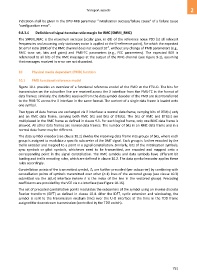Page 761 - 5G Basics - Core Network Aspects
P. 761
Transport aspects 2
Indication shall be given in the DPU-MIB parameter "initialization success/failure cause" of a failure cause
"configuration error".
9.8.3.4 Definition of signal-to-noise ratio margin for RMC (SNRM_RMC)
The SNRM_RMC is the maximum increase (scalar gain, in dB) of the reference noise PSD (at all relevant
frequencies and assuming only stationary noise is applied at the U-reference point), for which the expected
-7
bit error ratio (BER) of the RMC channel does not exceed 10 , without any change of PMD parameters (e.g.,
RMC tone set, bits and gains) and PMS-TC parameters (e.g., FEC parameters). The expected BER is
referenced to all bits of the RMC messages at the output of the RMC channel (see Figure 9-1), assuming
that messages received in error are not discarded.
10 Physical media dependent (PMD) function
10.1 PMD functional reference model
Figure 10-1 provides an overview of a functional reference model of the PMD at the FTU-O. The bits for
transmission on the subscriber line are received across the interface from the PMS-TC in the format of
data frames; similarly, the data bits received from the data symbol decoder of the PMD are also transferred
to the PMS-TC across the interface in the same format. The content of a single data frame is loaded onto
one symbol.
Two types of data frames are exchanged via interface: a normal data frame, carrying bits of DTU(s) only
and an RMC data frame, carrying both RMC bits and bits of DTU(s). The bits of RMC and DTU(s) are
multiplexed in the RMC frame as defined in clause 9.5. For each logical frame, only one RMC data frame is
allowed. All other data frames are normal data frames. The number of bits in an RMC data frame and in a
normal data frame may be different.
The data symbol encoder (see clause 10.2) divides the incoming data frame into groups of bits, where each
group is assigned to modulate a specific subcarrier of the DMT signal. Each group is further encoded by the
trellis encoder and mapped to a point in a signal constellation. Similarly, bits of the initialization symbols,
sync symbols or pilot symbols, whichever need to be transmitted, are encoded and mapped onto a
corresponding point in the signal constellation. The RMC symbols and data symbols have different bit
loading and trellis encoding rules, which are defined in clause 10.2. The data symbol encoder applies these
rules accordingly.
Constellation points of the transmitted symbol, Zi, are further precoded (per subcarrier) by combining with
constellation points of symbols transmitted over other (n-1) lines of the vectored group (see clause 10.3)
submitted via the ε(k,n) interface (where k is the index of the line in the vectored group). Precoding
coefficients are provided by the VCE via ε-c interface (see Figure 10-16).
The set of precoded constellation points modulates the subcarriers of the symbol using an inverse discrete
Fourier transform (IDFT) as defined in clause 10.4. After the IDFT, cyclic extension and windowing, the
symbol is sent to the transmission medium (line) over the U-O interface at the time in the TDD frame
assigned for downstream transmission (controlled by the TDD switch).
751

